#araragi koyomi render
Text
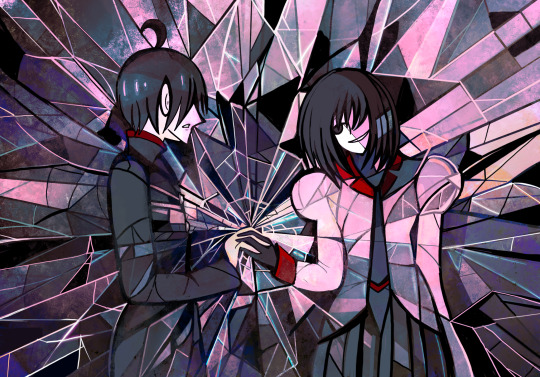
Revisiting this one at random because. I miss Ougi.
#owarimonogatari#oshino ougi#araragi koyomi#bakemonogatari#and you know my ever increasing obsession with rendering shattered glass so I wanted to update with that#my art
233 notes
·
View notes
Text
Tsubasa Tiger - An Analysis
This is an arc about personal identity, which is fitting for the first book in the series narrated by someone other than our main character. Tsubasa’s halting attempts to discover herself feel almost in parallel to Nisio’s attempts to expand her internal world beyond that perceived by Koyomi.
It quickly becomes evident that Hanekawa Tsubasa does not know herself, the usual catchphrase of ‘I only know what I know’ recontextualised with the understanding that there are many things she does not know on purpose. This is what Izuko tells her, and note that for all her talk of Tsubasa knowing nothing, the specific facts that she focuses on - the tiger, Tsubasa’s feelings for Koyomi, the cram school burning down - are things that Tsubasa should know about. Izuko doesn’t stun her with information that would be impossible for Tsubasa to obtain, but rather things that it should be impossible for her to not know.
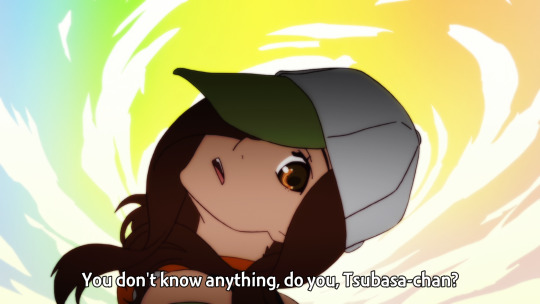
This absence is at the heart of this arc’s central oddity, the titular tiger. It’s rendered variously as the Tyrannical Tiger, Hystery Tiger, History Tiger, etc. I think the most immediately relevant things to draw on when talking about it are how it symbolises both the past and Tsubasa’s strong emotions. However, in her usual fashion, neither of these are immediately obvious in the tiger, which appears out of nowhere, rooted in no history, motivated by no emotion. It is singularly uninterested in these things, and that is precisely why it is useful to her.
Its role is to burn the past. It is powered by her ‘dark’ emotions, but is not itself touched by them. Its habit of arson is found in her envy, the repressed desire for a home of her own leading her to destroy those of others. She also, in a more personal sense, envies the family. Her parents growing closer to one another. Hitagi and her father. The Araragi siblings and their mother.
The reason, then, why she manages to stop herself from destroying their houses as well is because of the genuine intimacy and love that she manages to build with Hitagi and the Fire Sisters (as partially represented by the shower/bath scenes). She never manages to hate Hitagi for ‘taking’ Koyomi from her, because despite loving Koyomi she ends up a little bit in love with Hitagi too.
Over all three of Tsubasa’s arcs we’ve slowly been approaching the truth of the similarity between Koyomi and Tsubasa. The difference between them and Hitagi, or Kanbaru.
Tsubasa is someone that resists change, refuses to move forward. To some extent the backwards chronology of her first two arcs doesn’t matter because the conclusion is almost the same. Just don’t worry about it. Continue as normal. This can seem a frighteningly noble thing, from Koyomi’s perspective. It is a frighteningly broken thing, to Tsubasa.
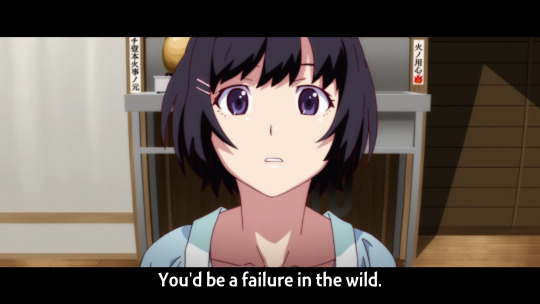
Hitagi says she’s a ‘failure as a creature’. That she has no sense of danger, simply accepting everything as it comes. The concept of the ‘wild creature’ invoked here is obviously connected to how her oddities manifest as animals, holding the instincts and impulses that she rejects in herself. She eats her food unseasoned, not because she prefers it that way, but because the difference in taste doesn’t matter to her. She approves of goodness to the exact same extent she approves of tediousness, of flavourlessness, of banality. In that sense, Hitagi questions, can even her love for Koyomi be considered real? Does she have a reason to prefer him in particular?
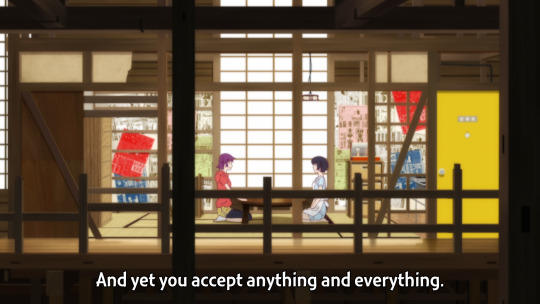
We’ve been told that she’s the ‘real deal’ in comparison to Koyomi’s fake, but what that turns out to mean is simply that Koyomi has a basic level of self-awareness. He knows how it looks to others, to be so self-sacrificing. It makes you stand out. Tsubasa fails to recognise this - how else would she still have the misconception that she’s been correctly acting as a ‘normal girl’?
Besides that one point, the two are remarkably similar. Their lack of self-regard drives them into service of others, all the while stubbornly refusing to reach out for help on their own. Koyomi fails again and again, repeating the same mistakes, accepting his old hypocrisies, and through it all, remaining himself.
That’s why she loves him. Because he ‘confronts his own weakness’. Because when he saved Shinobu he was crying, and Tsubasa can’t remember the last time she herself cried.
The second chapter ends with Tsubasa noting that she always gives thanks after a meal, for the plants and animals that have been killed ‘for my sake, of all creatures.’ Especially after spring break, she says. After encountering a vampire, after witnessing what it is to be a vampire, to devour someone else’s life for your own sake. But here I also think about the cat. An animal that died on the side of the road. A predator, whose energy drain selfishly takes from others.
Just as Koyomi and Tsubasa are alike, so are their oddities. They both take the form of creatures that are capable of imposing on others, of asserting their own desires over those of others, and for that reason the both of them are deathly afraid of letting them out. They shrink back inside themselves, trying their best to avoid bumping into anyone else, to avoid cursing them with their touch.
But where Koyomi, in his fumbling way, makes progress & reconciles with Shinobu, Tsubasa casts her cat aside. She loses the memories of its rampage after it leaves. This doesn’t seem strange at first. We assume this is how the oddity works. It is how it works! For Tsubasa. The cat isn’t the one removing her memories, she just went ahead and did that on her own. Like she does with everything.
There’s a conversation between cat and vampire in this book. Shinobu brings up the tale of Napoleon sleeping in the bath & points out that two very abnormal things can combine to seem normal. Black Hanekawa is one such abnormal thing, an oddity, but going down this train of thought has Hanekawa wondering if she isn’t one herself, if her own ability to ignore inconveniences and tolerate the intolerable isn’t also something ambiguously supernatural.
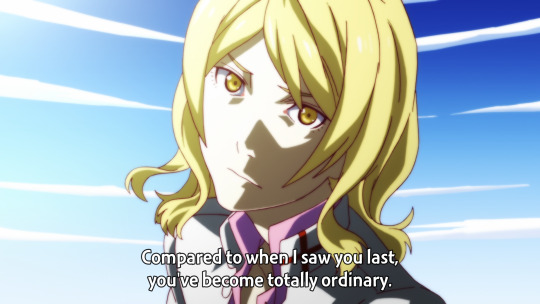
Episode says that she had an ‘overwhelming presence’ when he met her during spring break, that she almost seems normal now, having since cut off the cat from herself. Having cut off the tiger. It’s almost a contradiction. The more she relies on supernatural powers, the more normal she herself becomes.
Perhaps the model student persona of Hanekawa Tsubasa was also a constructed identity, constructed for the purpose of protecting herself, just as Kuro was.
After all, to a vampire’s eyes, there’s not much of a difference between human and oddity.

Again we have the oddity as a twisted reflection of its master. Shinobu sees everyone equally as food, while to Koyomi both humans and oddities are equally in need of his help. He saves Shinobu despite her monstrous nature, he saves Mayoi despite her being the cause of the incident. To him there’s no distinction, both Kuro and Tsubasa are Hanekawa.
We are going to be seeing nightmares for the rest of our lives, he tells Tsubasa in Neko Kuro. You will never stop being that person. Because when it comes down to it, he doesn’t, and neither does she.
It feels a little off. People can change, can’t they? People can always change. Does she really have to drag that cat, that tiger, around with her forever? In this book we get a more complete picture. What cannot change is the past. What happened, what you’ve done, that never goes away. You can become a different person as much as you like, as long as you never deny it. That the cat, the tiger, they were, are, both you. You can change as much as you like, but all of those changes, steps and missteps are still Hanekawa Tsubasa.
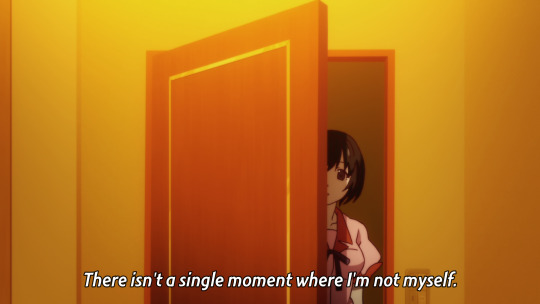
Her mistake was pretending that the cat wasn’t her, pushing everything onto Kuro as though it had nothing to do with Tsubasa herself.

As Gaen points out though, this is normal. Everyone goes through their life lying to themselves & each other to cope. Tsubasa isn’t special. What makes her special in this arc is accepting the oddities as part of herself, asking them to come home. Supposedly they’d disappear on their own. From both an oddity’s perspective, and a human perspective, that’s the preferable outcome. But just like Koyomi, Tsubasa doesn’t see this from an oddity’s perspective, or a human’s perspective. To her the cat and tiger have become family.
The theme of this series, then, really hasn’t changed from the first arc, where a girl without her weight takes back her emotions.
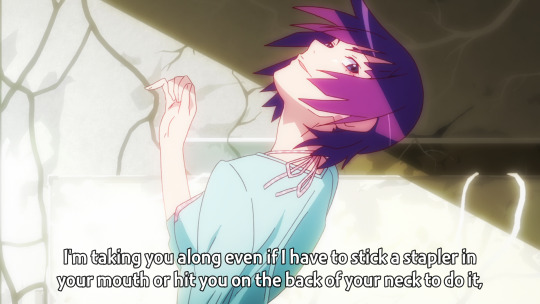

Hitagi and her own self-driven changes are vital to this arc, her affection for Tsubasa driving the girl to accept help freely given. Tsubasa still resists the idea of calling Koyomi, taking up his time, making her feelings known to him, and so both Hitagi and the Fire Sisters end up demonstrating the virtues of kindness freely given, what a family ‘should’ be like. This helps Tsubasa understand the character of her own family situation, one that she finally bluntly articulates as abuse.
Both Tsubasa and Koyomi have that tendency, looking away from uncomfortable truths in order to maintain their way of life. Take, for example, the situation with Kanbaru, where he’s just a bit too charitable, doesn’t quite understand how much she wants him dead. He’s unable to solve the incident on his own, unable to realise the problem with getting himself killed to solve it, and in the end is only able to provide a justification for Hitagi and Kanbaru to meet. To buy time for her to get there.
It’s an overstepping of bounds, a needless intervention, an unwanted favour. But it’s not pointless.
It’s a classic Koyomi-narrated arc, in that way. He’s a bit slow to understand the mind of the ‘victim’, is unsuccessful in his attempts in intervention when compared to Oshino, the specialist, and Kanbaru has to just go ahead and save herself.
Consider, now, the structure of Tsubasa Tiger. For once, our protagonist isn’t Koyomi. And yet, in a similar manner to Koyomi Vamp, we find the narrator herself to be the one afflicted by an oddity.
She’s a bit slow to understand what’s going on in the mind of the victim, has the situation laid out for her by Izuko, the specialist, and in the end -

Her attempts at intervention are unsuccessful. She can’t defeat the tiger on her own. She can only buy time.
Just as Koyomi’s business with Kanbaru is an overstepping of bounds, a needless intervention, an unwanted favour, Tsubasa’s business with the tiger is ‘impossible, reckless and-’
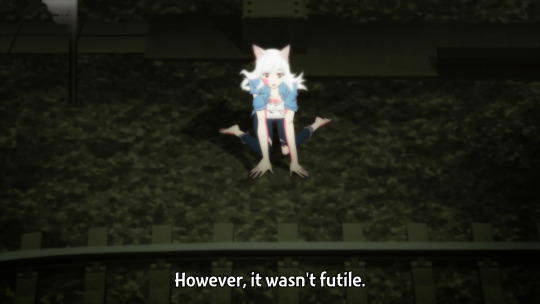
Not futile. Never pointless.
Isn’t the point of Koyomi in Suruga Monkey that without him risking himself, the two may never have come back together? That despite being unwanted, his selflessness is, in the end, appreciated?
The point of Tsubasa Tiger, then, is that people will come to help you if you call them. Koyomi demonstrates this in Nekomonogatari Kuro, with his text message trick. Here, in Shiro, Tsubasa returns the favour, finally reaching out to him by sending a picture, escaping the carefully constructed boundary of her school uniform, letting him know that she wants to stay in touch with him, that she doesn’t mind imposing on his time a little.
One might question the role of Koyomi in this narrative, appearing at the end to save the day. Isn’t this arc supposed to be about Tsubasa? Doesn’t she have to resolve her own issues? Do we not all have to save ourselves?
That was never true, though. Koyomi’s appearance at the end is almost an afterthought. It’s Oshino’s final proposal in Koyomi Vamp. It’s Hitagi’s arrival in Suruga Monkey. It’s Shinobu’s emergence from the shadow in Tsubasa Cat.
The protagonist role Tsubasa inherits from Koyomi is not the ability to solve incidents, it is the ability to help, to be there for someone. Just as Koyomi was able to face her feelings head on in Tsubasa Cat, willing to give up his life for her in Tsubasa Family, just how she was able to be a friend to Koyomi at his lowest point in Kizumonogatari -
For the first time in a while, the one that Tsubasa Hanekawa tries to take care of is herself.

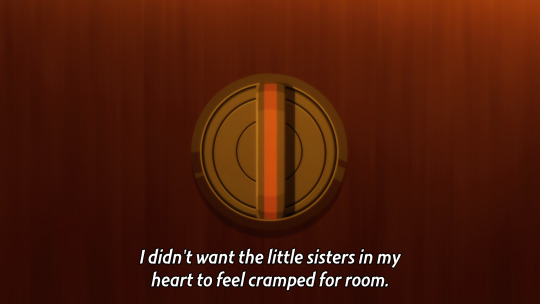
And that's all for now. This arc is great. Gonna have to hurry up a bit if I want to finish this before the new season comes out . . .
31 notes
·
View notes
Text
Hitagi Honeymoon
002
“Senjougahara-san? Is something up with Senjougahara-san?”
“Well, it's not that something’s up, I'm just curious.”
“Oh?”
“Don’t you think ‘Senjougahara Hitagi’ is a weird and interesting name?”
“…You know, ‘Senjougahara’ is a place name.”
Eighteen years back in time, such a conversation took place within a classroom of Naoetsu Private High School. It would be more accurate to say that it happened nearly six years ago, when I was an eighteen-year-old third-year senior in May. Regardless, it feels like a whole eighteen years have passed.
On that day—the very day I caught my classmate falling gracefully from the staircase above—it all began.
After school, I had thrown such a question at our class president, Hanekawa Tsubasa, who knew everything.
And the response I got was this: a place name.
In other words, there is a place named Senjougahara in Japan, and at that time, in adherence to the good sense one would expect of a narrator who takes pride in promptly cutting out chit-chat that bears no relation to the main storyline, the conversation quickly progressed with utterances such as, “Ah, um, that's not what I meant. What I was trying to say is, well, it's about her first name.”
Now, with the passage of time, we shall deliver the director's cut version. It is not often that a director's cut version of a film or the like receives rave reviews, but there can be no success without challenge.
“Oh, a surname derived from a place name? That's the first time I've ever heard of it. You know everything!”
“I don't know everything, I only know what I know.”
Said Hanekawa Tsubasa, casually brushing off the remark during her glasses-wearing days, her hair in three braids—the line itself now rendered nostalgic.
Fast forward six years to the present, and she has vanished not just in name but in existence altogether. To Hanekawa, who had been constantly moving from one family household to another—her parents always somewhere else—names must have seemed more or less inconsequential from the start.
No name was ever permanent, all just transient and fleeting.
Araragi Koyomi at eighteen, just after Golden Week, may have been well aware of this, but he had not yet felt the importance of names.
“Is it like Sekigahara or Dannoura? Or perhaps, like Horagatouge?”
She interjected with a sense of aesthetic that seemed slightly misaligned.
“Hmm, I think Senjougahara is a bit different from those famous battle sites.”
“Really? Where is it, then?”
The young Araragi, who had yet to begin studying for his exams, did not even know the location of Sekigahara, let alone the year of the famous battle that took place there.
“In Tochigi Prefecture.”
“Tochigi?”
Allow me to carefully insert a subtitle here: this conversation took place six years ago—or indeed eighteen—and has been recorded as is to preserve the historical context and culture of that time.
“Where is that? Within the country?”
“Maybe it'd be easier if I say Nikko?”
“Nikko…”
When uttered with such a charming smile¹ (which, in human terms, would soon be followed by an encounter in the hallway with a high school girl embodying the epitome of the sarcastic tongue), the malicious air seemed to dissipate. Indeed, the young Araragi understood the reference to Nikko, but when asked where Nikko was, he was still clueless.
In fact, he seemed even more tense.
For young Araragi, who retained his vampiric nature as a consequence of his Spring Break, sunlight was a two-syllable word to be shunned. The memory was still fresh back then.
“Senjougahara is in Oku-Nikko. In the upper left part of Tochigi Prefecture on the map.”
“I remember now. Nikko, 'If you haven't seen Nikko, you haven't seen anything.’”
“Yep, yep.”
Said a seemingly well-accomplished Hanekawa. Reflecting on it now, the honor student had already started to educate me since then, even with our organizing a gathering to decide on a cultural festival performance. Well, it could be considered cultural.
“It's like seeing Naples before you die. So, what kind of battle took place in that Oku-Nikko? It looks like there's nothing there.”
I said, eighteen years ago. Furthermore, it was the utterance of a high school student who did not fully know his age. It's the age when one thinks they're being sharp by disrespecting a regional city they don't know well due to lack of information, even though their own address is quite provincial.
Nowadays, such non-compliance is unthinkable.
“No way there's nothing there. There's plenty. Lake Chuzenji, Kegon Falls, Futarasan Shrine, Nikko Toshogu Shrine… Nikko Toshogu Shrine is a World Heritage site.”
“Really… aren't World Heritage sites surprisingly everywhere, though?”
Eighteen years ago, the words were spoken.
Although I am the one bringing it up now.
“There is a designated history that exists everywhere, to be carefully preserved.”
It does hold a profundity.
It’s hard to believe that this was said by a high school junior just like Araragi, eighteen years ago.
However, even if not a World Heritage site, I have definitely heard of Nikko Toshogu Shrine... Wasn't it built by Tokugawa? Or his grandson? I'm not sure, but on this matter, there isn't much difference between the me back then and the me now. If anything, the only distinction is that today, I am aware of the Sleeping Cat, a sculpture by the master Hidari Jingorou, in that World Heritage site.
Cat…
“Futarasan Shrine, it’s somewhat like my name, isn’t it? And Senjougahara, huh… Is that where you're from?”
“Hmm, who knows?”
Class President evasively rubbed her shoulder, negating the vulgar and probing reiteration of her origins, a habit she maintained consistently since that time.
But at any rate, it is possible that this is her birthplace, as the story I was to hear later from Hanekawa revealed that she lived in this town since at least her junior high school days.
“The battle was fought by gods.”
“Gods?!”
“The god of Mount Nantai in Tochigi Prefecture and that of Mount Akagi in Gunma Prefecture clashed.”
“Tochigi and Gunma? They fought?”
Let that be corrected. Even eighteen years ago, this was not an acceptable statement.
“What for?”
“Let me inform you, Araragi-kun, that there were no borders between prefectures at that time. The mountains were equivalent to the gods themselves.”
“I have heard that before… So that's why mountains are counted as 'seats,' right? A place for the gods to sit… Then, in that battleground, Hachimanbara, who emerged victorious? Not that it matters.”
“Do not say it doesn't matter.”
She chastised me, making me feel like I had been scolded by a braided, bespectacled class president from across eighteen years into the past. It was not an entirely unpleasant feeling; a sci-fi sort of feeling.
Such a figure no longer exists, however.
“From the fact that the battle had reached Hachimanbara in Tochigi Prefecture, it is evident that Gunma Prefecture had the upper hand. It was where the god of Mount Akagi had transformed into a giant centipede and launched an attack.”
“A giant centipede.”
“The battle was met by the god of Mount Nantai in the form of a snake…”
“A snake.”
“But ultimately, it was a man named Saru Maruo who repelled the centipede by shooting its eyes with arrows.”
“Saru, 'monkey'…”
Of course, I don't possess foresight, so although the snake and monkey may seem to be significant, they could simply be elements of an incredible tale that I cannot grasp entirely.
Undoubtedly, the same could be said for the giant centipede's role in the story.
It is not impossible to connect the centipede biting people with vampirism.
“In summary, the Battlefield Plain of Oku-Nikko is where those two gods clashed, which could explain the seemingly endless marshland that stretches across the horizon without anything to obstruct the view.”
“There's nothing there, though?”
“It's not that there's nothing, your perception just isn't the sole perspective. For instance, at night, as far as the eye can see…”
Stars fill the sky.
Hanekawa Tsubasa spoke as if it were her catchphrase, yet little did I know that just a month later, I would go on my first date with my first girlfriend at an observatory I knew nothing about.
“I see. That's neat. Awesome.”
I had little to say other than lightly nodding and agreeing.
“But…”
Then, somewhat deflatedly, I tried to shift our conversation back to the topic.
“Ah, um, that's not what I meant. What I was trying to say is, well, it's about her first name.”
Prev Chapter | Next Chapter
Nikko is a city in Tochigi pref., and にっこり(nikkori) is charming smile.
9 notes
·
View notes
Text
UNO STRANO EFFETTO DELLA PAROLA "CORAGGIO"
Tempo fa ho visto tutte le serie di un anime (così si chiamano i cartoni animati giapponesi) intitolato "Monogatari".
L'opera è un capolavoro con personaggi complessi e dialoghi memorabili, malgrado alcuni classici difetti di molti anime, come la presenza sovrabbondante del cosiddetto "fan service", spesso caratterizzato da ammiccamenti del tutto gratuiti a talune perversioni (che includono forme di molestia sessuale) senza neppure un accenno di collegamento alla trama o allo sviluppo dei personaggi.
Non scendo nei particolari perché a questo profilo sono affezionato e non voglio correre il rischio che sia disintegrato dalla spietata polizia democristiana dei social network. Oggi mi gira così. Voglio che il post sia completamente asettico.
A proposito, mi è tornata in mente la scena in cui un personaggio femminile fa una scommessa con Koyomi Araragi, il protagonista. La posta in palio è collegata alle perversioni del ragazzo. Ma la questione più interessante è proprio l'oggetto della disputa.
Lei scommette di poter dimostrare che la parola "coraggio" si può usare per manipolare la comunicazione e descrivere qualsiasi azione esecrabile come se fosse un comportamento degno della massima stima.
Basta aggiungere "coraggio" e il gioco è fatto.
Per essere convincente fa diversi esempi allo scettico Araragi. Non li ricordo tutti, quindi alcuni devo inventarli, ma il concetto non cambia. Tanto per rendere l'idea, ecco un piccolo elenco: il coraggio di far del male a qualcuno, il coraggio di tradire gli altri, il coraggio di mentire, il coraggio di ingannare, il coraggio di sacrificare vite umane, il coraggio di sganciare una bomba.
Alla fine Araragi si arrende e lei vince la scommessa.
Ho ricordato questa scena quando Salvini ha pubblicato una foto per mostrare se stesso in posa eroica. Nella foto c'era una barca in mezzo al mare, piena di migranti in fuga dalla disperazione. E c'era anche la scritta: «Torna la sicurezza, torna il coraggio».
Già, proprio quel coraggio lì...
[L'Ideota]
47 notes
·
View notes
Photo

#ken renders#ken renders ononoki yotsugi#monogatari#monogatari render#monogatari ononoki#monogatari ononoki yotsugi#monogatari araragi#monogatari araragi koyomi#araragi koyomi#araragi and ononoki#araragi koyomi render#ononoki yotsugi#ononoki yotsugi render#ononoki yotsugi kawaii#monogatari series#物語
31 notes
·
View notes
Photo
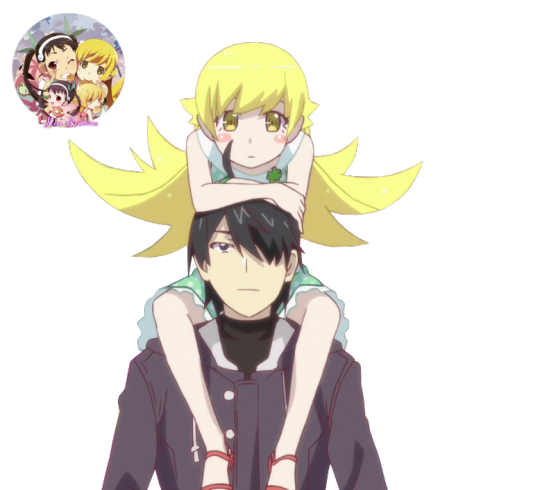
#ken renders#ken renders oshino shinobu#monogatari#monogatari shinobu#monogatari shinobu x araragi#monogatari shinobu oshino#shinobu x araragi#shinobu oshino#shinobu oshino render#araragi x shinobu#araragi x shinobu render#monogatari render#monogatari series#物語#araragi koyomi#araragi koyomi render#monogatari araragi koyomi
5 notes
·
View notes
Photo

#ken renders#monogatari#monogatari araragi#monogatari araragi koyomi#monogatari koyomi araragi#monogatari render#araragi koyomi#araragi koyomi render#koyomi araragi#koyomi araragi render#male anime render#monogatari series#物語
4 notes
·
View notes
Photo

#ken renders#ken renders oshino shinobu#monogatari#monogatari shinobu#monogatari shinobu x araragi#monogatari shinobu oshino#monogatari araragi#monogatari araragi koyomi#monogatari araragi x shinobu#monogatari render#monogatari series#shinobu x araragi#shinobu oshino#shinobu oshino render#araragi koyomi#araragi koyomi render#物語
4 notes
·
View notes
Photo

#ken renders#monogatari#monogatari render#monogatari araragi#monogatari araragi koyomi#monogatari koyomi araragi#monogatari series#male anime render#物語#araragi koyomi#araragi koyomi render#koyomi araragi#koyomi araragi render
4 notes
·
View notes
Photo

#ken renders#ken renders oshino shinobu#monogatari#monogatari render#monogatari shinobu#monogatari shinobu oshino#monogatari oshino shinobu#shinobu oshino#shinobu oshino render#female anime render#monogatari series#monogatari shinobu x araragi#monogatari araragi x shinobu#shinobu x araragi#araragi koyomi#araragi koyomi render#monogatari araragi koyomi#物語
3 notes
·
View notes
Photo

#ken renders#ken renders hachikuji mayoi#monogatari#monogatari hachikuji#monogatari hachikuji mayoi#monogatari araragi#monogatari araragi koyomi#araragi x hachikuji#monogatari araragi x hachikuji#hachikuji and araragi#araragi koyomi#araragi koyomi render#hachikuji mayoi#hachikuji mayoi render#物語
2 notes
·
View notes
Photo

#ken renders#ken renders oshino shinobu#monogatari#monogatari render#monogatari shinobu#monogatari shinobu x araragi#monogatari araragi#monogatari araragi x shinobu#oshino shinobu#oshino shinobu render#araragi koyomi#araragi koyomi render#araragi x shinobu#araragi x shinobu render#物語#monogatari series
2 notes
·
View notes
Photo

#ken renders#monogatari#monogatari araragi#monogatari araragi koyomi#monogatari koyomi araragi#araragi koyomi#araragi koyomi render#koyomi araragi#koyomi araragi render#male anime render#物語#monogatari series
2 notes
·
View notes
Photo

#ken renders#ken renders hachikuji mayoi#monogatari#monogatari hachikuji#monogatari hachikuji mayoi#hachikuji mayoi#hachikuji mayoi render#monogatari araragi#araragi x hachikuji#araragi koyomi#araragi koyomi render#物語#mayoi hachikuji#mayoi hachikuji render#hachikuji and araragi#monogatari series
2 notes
·
View notes
Photo

#ken renders#ken renders oshino shinobu#monogatari#monogatari shinobu#monogatari oshino shinobu#monogatari araragi#monogatari araragi koyomi#oshino shinobu#oshino shinobu render#araragi koyomi#araragi koyomi render#araragi x shinobu#araragi x shinobu render#araragi and shinobu#shinobu x araragi#monogatari shinobu x araragi#monogatari araragi x shinobu#物語#monogatari series
3 notes
·
View notes
